- HOME
- > 一般の方
- > バックナンバー:神奈川歯学
- > 42巻2号
- > アブストラクト
アブストラクト(42巻2号:神奈川歯学)

Japanese
| Title : | 高弾性ナイロン樹脂による床用レジンの色調安定性 |
|---|---|
| Subtitle : | 原著 |
| Authors : | 勝俣友樹, 北條了, 井野智, 濱野奈穂, 渡辺智良, 近藤永*, 戸田篤志**, 鈴木彰***, 豊田實 |
| Authors(kana) : | |
| Organization : | 神奈川歯科大学顎口腔機能修復科学講座歯科補綴学分野, *近藤歯科医院, **戸田歯科医院, ***アキラ歯科医院 |
| Journal : | 神奈川歯学 |
| Volume : | 42 |
| Number : | 2 |
| Page : | 140-145 |
| Year/Month : | 2007 / 12 |
| Article : | 原著 |
| Publisher : | 神奈川歯科大学学会 |
| Abstract : | 「緒言」近年, 金属製クラスプによる審美性の低下やアレルギーへの対応として, 各種軟性レジンが注目されている1). 中でもナイロン樹脂系床用レジンは, 高弾性の性質を持つことから, メタルフリーデンチャーとして使用されている. ナイロン樹脂系レジンはPMMA系と異なり, 加熱成型により加工するため, 成型・加工時に化学的重合反応を必要とせず, 重合収縮時の変形や未重合モノマーの残存といった欠点を排除した材料と考えられている. このような利点を持ちながら, 物性に関する詳細な報告が少なく2), 患者のQOL向上に伴う社会的ニーズに対応するため, 臨床に用いられているのが現状である. そこで, 本研究ではナイロン樹脂の色調安定性を測定し, さらに吸水性, 接触角, 表面自由エネルギーの観点から, 各種床用材料と比較し, 床用材料としての応用が可能であるかを検討した. 実験材料および方法 1. 使用材料 本実験に用いたナイロン樹脂系床用材料(Lucitone FRS, Dentsply, 以下LTとする)と, 比較対象として用いたポリカーボネート樹脂系床用材料(Bio Carbo Resin, High Dental Japan, 以下BCとする), 加熱重合型床用レジン(SR Ivocap Plus High Impact, Ivoclar-Vivadent Inc, 以下IVとする), 加熱重合型床用レジン(Luxon, GC, 以下LXとする), 加熱重合型床用レジン(Quick Acron, GC, 以下QAとする)の, 計5種類を表1に示す. |
| Practice : | 歯科学 |
| Keywords : | ナイロン樹脂, 床用レジン, 色調安定性 |
English
| Title : | Color Stability of a Flexible Nylon Denture Base Resin |
|---|---|
| Subtitle : | |
| Authors : | Yuki KATSUMATA, Satoru HOJO, Satoshi INO, Naho HAMANO, Tomonaga WATANABE, Nagao KONDO*, Atsushi TODA**, Akira SUZUKI***, Minoru TOYODA |
| Authors(kana) : | |
| Organization : | Division of Prosthetics, Department of Oral and Maxillofacial Rehabilitation, Kanagawa Dental College, *Kondo Dental Clinic, **Toda Dental Clinic, ***Akira Dental Clinic |
| Journal : | Kanagawa Shigaku |
| Volume : | 42 |
| Number : | 2 |
| Page : | 140-145 |
| Year/Month : | 2007 / 12 |
| Article : | Original article |
| Publisher : | Kanagawa Odontological Society |
| Abstract : | Highly elastic nylon resin denture base material is used for metal-free dentures in response to the allergic reactions and demand for greater aesthetic appeal. However, there are few detailed reports about the mechanical properties of this material. Therefore, in this study, the color stability of the nylon resin denture base material (Lucitone FRS : LT) was investigated. Differences in the color of groups with and without thermal cycling (20,000) were measured. Both groups were stored in a coffee liquid for 1-4 weeks. In the same sample, the color differences were measured every week. Furthermore, the water absorptivity, contact angle with water and diiodomethane, and the surface free energy of each material were measured. The results of this study indicated that LT easily changed color. For this reason, it was thought that LT is easy to be affected by various surface properties because of its high transparency compared with other materials. However, compared with resins used in conventional denture base material, water absorptivity is low in LT, contact angle is large, and surface free energy is low. Therefore, it is thought that LT can be superior in terms of water-repellency and oil-repellency. |
| Practice : | Dentistry |
| Keywords : |
